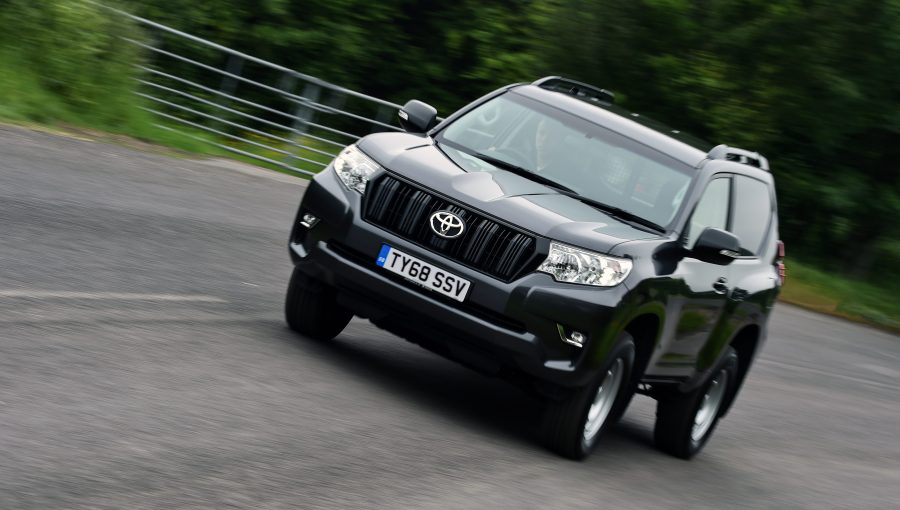Although Toyota’s passenger car range is predominantly focused around petrol-electric hybrid powertrains, the Land Cruiser, Hilux and Proace models are fitted with diesel engines. A diesel particulate filter (DPF) is a feature of these models, and you may have heard about the need for regular DPF regeneration. What does this component do and how do you take care of it?
What does a diesel particulate filter (DPF) do?
The DPF is fitted within the exhaust system and is designed to catch soot particles and nitrous oxide (NOx) from the combustion process that would otherwise be released into the atmosphere. The DPF is highly effective and traps around 80% of these harmful particulates.

Why do modern diesel engines need a DPF?
European legislation places strict exhaust emissions targets on all vehicle manufacturers. From September 2009, the Euro 5 legislative standard came into effect, part of which required all diesel cars registered from that point on to be equipped with a diesel particulate filter, or DPF.
These filters are used throughout the industry in all diesel-powered passenger vehicles, and their efficiency is vital now that stringent Euro 6d emissions standards are in force.
Do I need to replace a DPF during normal servicing?
Diesel particulate filters do have a capacity limit and can become full. But unlike traditional air, oil or pollen filters that need to be exchanged manually at regular intervals, the DPF has a much longer service life and is designed to regenerate to restore its performance.
The car’s electronic control unit (ECU) is programmed to do this automatically, neutralising the soot by burning it off at high temperature within the exhaust system while the vehicle is running. All modern cars with diesel engines follow this procedure.

How does DPF regeneration occur?
The regeneration occurs automatically, usually without the driver being aware that it is taking place. In the majority of cases, the process is carried out when the engine and exhaust system has reached normal operating temperature and the vehicle is travelling at over 40mph.
However, if your driving is limited to urban areas, the low speeds and frequent stops mean the conditions for normal regeneration do not exist. In these instances, the ECU monitors the accumulation of soot and instructs an alternative regeneration programme to begin well before the filter becomes saturated.
This programme injects small quantities of fuel into the engine after combustion, which increases the temperature within the exhaust system and creates an environment where it is possible to safely burn off the soot.
This method is very successful within the small percentage of vehicles where normal regeneration is not possible. However, due to the nature of city traffic, the regeneration process can be interrupted when the vehicle completes its short journey and is turned off. If this occurs, the ECU is programmed to recommence the process when the engine is restarted and back up to temperature again.

How can I help prevent DPF blockages in my Toyota?
Follow these four simple actions:
1. Regularly drive your Toyota on highways at speeds of between 40-55mph for around 20-30 minutes.
2. Avoid spending unnecessary amounts of time with the engine idling.
3, Try to limit the frequency of short journeys where the engine is running for less than ten minutes.
4. Do not ignore dashboard alerts related to the DPF.
Will I be warned if all DPF regeneration processes have been unsuccessful?
Very occasionally, use of the vehicle might be such that it will have been impossible for the ECU to complete the administration of any regeneration procedure. At this point, the DPF will have become overloaded and stopped functioning, so your Toyota will illuminate a warning light in the dashboard. It will then be necessary for the soot to be neutralised and the filter regenerated manually at a main dealer.
It is extremely unwise to ignore this visual warning as the DPF can become irreparably damaged. What’s more, it is illegal to remove the filter entirely.
Learn more: What is the exhaust gas recirculation valve and what does it do?





Hi,
I have a 2010 Rav4 2.2 DIESEL AUTO (VIN JTMBB31V90D049690) that periodically produces dense clouds of grey smoke at 2000rpm when the engine is warm. My dealer was unable to replicate this when under warranty and could not explain the cause. It is now worse and I am concerned the DPF may need replaced. Can you please advise?
Kind regards, Colin
Hi Colin,
The vehicle should be taken to your local Toyota Centre for inspection and to diagnose the root cause of the issue. Dark grey or black smoke usually indicates over fuelling. When the DPF regeneration takes place, the fuel injection system will increase the amount of fuel injected, so this could be the reason for the smoke being produced periodically.
Carrying out a forced DPF regeneration would normally be the first step before replacing the DPF, although DPF regeneration will take place during specific driving operation. It is therefore important that vehicles fitted with a DPF carry out a suitable journey in order that DPF regeneration takes place. Typically a motorway journey for 30 minutes, allowing the engine and exhaust system to get up to temperature and burn away soot particles that may have accumulated in the DPF. Holding lower gears so that the rpm increases will also assist this process.
Hope this helps.
Does my Toyota Hilux 2015 SR vin MROFZ22G901207035 have a DPF filter?
Hi Andrew,
Unfortunately we cannot recognise the VIN provided, please double check this and get back to us. Alternatively, you could provide your reg which we could use to look into this further.
Thanks.
does my car fl65zxg have a dpf.
The orange spanner light has come on. I do 90 mins fast driving every day. how will i know if and when there is really some damage going to happen. If its going to cost 2000 then i will just risk it
I guess i will try a fuel additive just in case it helps.
It sounds from this forum as if i should keep driving it with the warning light on because the dealers dont always know what will cure this?
Hi Geoff,
Thanks for getting in touch.
Your vehicle does have a DPF.
The warning light you are referring to may just be the engine oil change/servicing reminder light and not an actual indication of an engine fault. However, we would advise that you take it to your local Toyota Centre should you have any concerns and for diagnosis. You can find you local Toyota Centre through the following link: https://www.toyota.co.uk/find-your-dealer.
If you are concerned about your DPF blocking, the driving pattern you report should enable the DPF to automatically regenerate.
We hope this helps.
Thanks.
Thank you for coming back to me, which type/model DPF is fitted to my vehicle?
Thank you Guy
Hi Guy,
It is unlikely that we will be able to obtain this information, however, if you can provide us with your VIN number we can look into this further for you.
Thanks.
Thank you coming back to ne, the VIN is as follows AHTFZ29G709097319
regards Guy
Hi Guy,
It is a standard Toyota DPF for the KD engine.
Thanks.
Hi, I appreciate this forum. I have a Toyota Avensis T25 D-CAT. It shows an engine warning light and the problem code after my diagnosis was P2002. What Can be the exact problem? Again does this my Avensis model car has a DPF warning light?
Hi Zakarov
Thanks for getting in touch. DTC P2002 is described as the following – Particulate Trap Efficiency Below Threshold (Bank1) . Therefore if this DTC is stored in your vehicle, you will have a DPF fitted. This DTC will generally mean that the DPF has deteriorated and will likely need replacing, however further diagnosis should be carried out to identify the root cause.
Hope this helps.
Can you please tell me if my 2008 Avensis has a DPF? VIN SB1DD56LIDE095213. Thanks.
Hi John,
Thanks for getting in touch. Although your vehicle will not have a DPF, it should have a DPNR. A DPNR is similar to a DPF, but doesn’t do an active regen. This is a similar principle to a catalytic converter on a petrol car.
Hope this helps.
Thanks
Does a 2006 D4D Toyota Yaris have a DPF
Hi Lee,
Thanks for getting in touch. If you could please provide a reg or VIN number then we will be able to assist you further.
The registration of the Toyota Yaris is WN56FFU
Hi Lee,
Your vehicle doesn’t have a DPF.
Hope this helps.
When year/registration were diesel particulate filters first installed on Toyota Yaris in the UK
Hi Lee,
Thanks for getting in touch. Diesel particulate filters were first installed on Toyota Yaris in the UK in November 2008.
Hope this helps.
Hi would my yaris fe10ujx have a dpf and would a diesel particulate filter cleaner help engine efficiency, thanks
Hi Izzy,
Thanks for getting in touch. Yes, the vehicle has a DPF. The system is set so that all cleaning is carried out during the normal drive cycle.
Hope this helps.
It has helped, thanks for your time
Hello,
Does my Toyota Yaris D4D VIN: VNKKC96340A065229 have a DPF filter?
Thanks.
Hi Ersin,
Thanks for getting in touch. Apologies for our last reply with inaccurate information. We can confirm that your vehicle does not have DPF filter.
Hope this helps, apologies again.
In my previous comment you said that my Toyota Yaris D4D registration WN56FFU did not have a DPF and furthermore that all Yaris’s before November 2008 did not have a DPF. Yet on the thread above you are saying that ALL D4D engines have a DPF. Talk about confused!! So what is the actual truth. Does the Yaris WN56FFU definitely not have a DPF and if this is correct why are you telling the person above that all D4D engines have a DPF. I have come on this Blog to get accurate information before making a purchase of a Yaris without a DPF and I am rapidly losing faith that the information you are passing on to people is inaccurate. Please could you clear this up once and for all.
Hi Lee,
Thank you for noticing this inaccuracy and we apologise for passing on the wrong information. We can confirm that your vehicle does not have DPF filter. We take the accuracy of our information very seriously and therefore apologise for the inconsistency of our replies in this instance.
Thanks.
Does Toyota Yaris D4D diesel reg. SW57 DDY have a DPF filter?
Hi Lee,
Thanks for getting in touch. This Yaris does not feature a DPF filter.
Hope this helps.
Is the Yaris 5 speed d4d (2007 model) supposed to have turbo lag as I drove one today and it did not appear to have any lag from the turbo although it accelerated and got up to speed well enough.
Thank you TOYOTA UK, thank you Lee,
I was a little confused after first Toyota UK’s answer, but after its reply I am clarified. As I know, almost all diesel cars manufactured before 2008 year don’t have DPF.
Hi my car toyota avensise d4d smoking from exhaust most time when i going up hill started smoking from exhaust i went to few garage they told my maybe dpf or fuel injector my car doing blu and graysh and unburn fuel smell white I went few times to toyota dealers they can’t found problem
Hi Fazal,
Thanks for getting in touch.
Our Customer Relations team will be happy to help you with this.
You can contact them here: https://www.toyota.co.uk/contact-us/.
Thanks.
Hi, Can you tell me if car reg P3 TGT D-4D yaris has a DPF filter please?
Hi Kerrie,
Thanks for getting in touch. This Yaris does not have a DPF filter.
Hope this helps.
Hi Lee,
Some degree of turbo lag will often be experienced on single turbocharger engines, such as the 1ND-TV engine which should be fitted to this Yaris. That said, the turbocharger and engine ECU have been designed to give optimum performance and fuel economy, with a very linear and progressive power delivery. You therefore may not experience any turbo lag at all. If however there is a sever lack of power and performance, this could indicate a fault with the turbocharger.
Hope this helps.